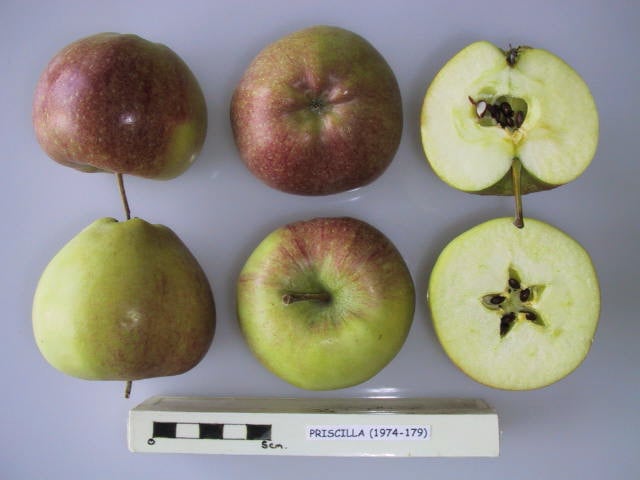Pomiferous
Welcome to the world's most extensive apples (pommes) database.
Information on over 7,000 apples is available here, all carefully researched and provided in a way that is easy to navigate.
Co-op 4

type: Culinary, Cider, Dessert
synonyms: Marketed as Priscilla
summary: One of about 50 apple cultivars developed under the PRI (Purdue University, Rutgers University and the University of Illinois) programme using Malus floribunda 821 to develop apple varieties that are genetically resistant to scab. Introduced in 1972.
identification: Small to medium size and round conical with slight crowning and vaguely ribbed. The skin is smooth, medium thick with a waxy feel and no russetting. The base colour can vary from green yellow to pale yellow to cream over which is a bright red wash that covers almost all the surface and lightly striped. Small white lenticels. The calyx is verly small and closed, set in a medium deep and narrow basin surrounded by a knobbed crown. A slender, long stem is set in a medium deep and narrow cavity.
characteristics: The flesh is cream-coloured, medium-grained, crisp, sweet and moderately juicy with a mild tartness. Licorice and pineapple aromas.
uses: An excellent dessert apple. In cooking, it tends to hold its shape well. It also makes an interesting addition to cider providing tartness and interesting flavours.
origins: Created in 1960, Priscilla was the developed by the cooperative breeding program between Purdue, Rutgers and Illinois State Universities (U.S.A.). Its parentage is Starking Double Red Delicious (flower parent) and PRI 610-2 (pollen parent) and the first seeds were planted in 1962 at the Purdue University Agricultural Experiment Station in Lafayette, Indiana (U.S.A.) and they fruited in 1966. When Co-op 4 was finally released in 1972 after selection and testing, it was renamed in honour of Priscilla Hovde, wife of Frederick Boyd Hovde, seventh president of Purdue University.
cultivation: Moderately vigorous. Grows to medium size. Fruit tends to be small unless managed by post bloom thinning. Good for small orchards, not suited to large commercial operations.
cold storage: Does not store well for long periods, maximum two months. There seems to be some variation in the best storage period.
vulnerabilities: Very resistant to scab, resistant to fire blight and cedar apple rust. Better than average resistance to powdery mildew.
harvest: Ready for harvest in the middle of the fifth period. Cracking at the calyx when left to hang too long.
notes: A mix-up occurred at a major nursery during the early 1980s resulting in a cultivar that was not scab resistant to be sold as Priscilla. Due to the number of these apples having been sold, the error was impossible to correct and continues to cause confusion among growers. The problem cultivar is not scab resistant.
pollination group: E
pollination peak: 18
ploidism: Diploid. Self sterile.
cold storage weeks: 8
brix: 13.3
harvest period: 5
hardiness: 4
sg: 1.0538
Donate a cider?
©2016-2021 Pomiferous.com. All rights reserved